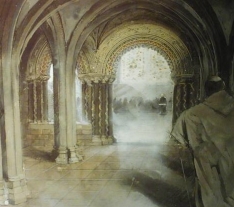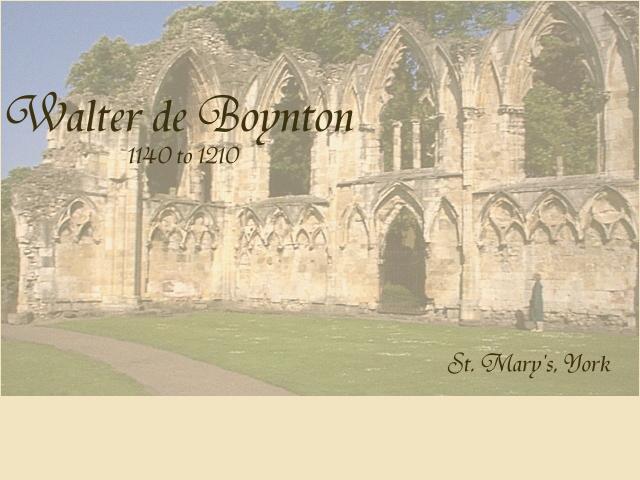Walter de Boynton lived in Yorkshire between 1140 and 1210.
The dates are not exact because dates were not recorded very often in the
12th century. He served as a justiciar of the court in 1208, he witnessed
a document in 1209, and he was dead before 1215. So we take 1210 as an ending
point. His birth is more complicated. He was old enough to have two daughters
join a priory sometime between 1168 and 1175. Assume he was fifteen when he
had daughters and they were fifteen when they went to the priory. That speculation
gives 1140 as a rough approximation of date of birth.
Family
Father: Stephen de Bouington was the father of Walter.
-
DATES: late 12th century
DESCRIPTION: Gift: Richard de Munceus to Walter son of Stephen de Bouington:
- - 7 1/2ac. in Bouington (i.e. 3ac. in North Langes; and 4 1/2ac. lying
between the boundaries of Carthorp and Bildesdale) - - : Rendering a pound
of cummin or 2d. yearly.
-
Witn. Engram de Bouington, Robert de Ulram, William de Carthorp,
John de Ruddestayn, William de Erhum, William de Hastorp
NOTE Estimated date; Hull Document.
-
This document belonged to the Boyntons of Burton Agnes. In the twentieth century
they deposited about 1,600 documents with the University of Hull; hence, Hull
Document. There is one other point to note about the document. Spelling was
flexible; Boynton was spelled many different ways across the centuries.
This is all we know about Stephen.
Daughters: There is no record of the name of Walter's wife. We do know
that he had two daughters.
225. Gift by Walter de Boynton to Watton priory of 4 bovates of land in Burnby,
the nuns having received his two daughters into their society as nuns. [c.
1168-1175]
Charles Travis Clay (1963) Early Yorkshire Charters, vol. 11,
p. 296.
Watton Priory had been established about 1150, and it was located within fifteen
miles of Boynton. Walter gave land to the priory when his daughters entered
as nuns; making a contribution in this circumstance was a fairly standard act.
[A Boynton Story: You
Want to Go Where?] We do not know anything more about his daughters, but
we do know that on several occasions he participated as a witness when others
made contributions to the priory. [A Boynton Place: Watton
Priory]
Sons: Walter's sons were William and Rabod.
William was his heir. Ingram was William's son and heir.
Walter, father of William, who is father of Ingelram de Bovyngtona, procured
from Richero Arnallia, in return for his service, 15 marks and one palfrey,
2 bovata of land in Arnilla, which Walter had given to us. Therefore, he
had this same William, his brother, and the said Richerum confirm his donation.
Edward A. Bond, ed. (1866) Chronica Monasterii de Melsa, vol.
I, For the Lords Commissioners of Her Majesty's Treasury, Under the Direction
of the Master of the Rolls, p. 222.
The line -- Stephen to Walter to William to Ingram began a family lineage that
continued until the middle of the twentieth century.
Rabod was a younger son of Walter about whom we know very little. Collier suggested
he may be the father of the line of Boyntons at Boynton (Collier,
chapter 3). We will follow his suggestion even though there is very little
evidence to sustain it.
We have found 12 documents that mention Walter and his family -- Walter
and Family.
Knighthood
Walter was almost certainly a knight. There are no lists so it
is difficult to be completely certain. But he held offices, such as deputy sheriff
[A Boynton Story: Deputy
Sheriff], that were generally occupied by knights. In the long history of
England, knighthood eventually became primarily an honor -- something one hopes
existed in one's family (Coss, 1993, pp. 1-4). In the 12th and 13th centuries,
however, knighthood was more responsibility than honor. It was, Baildon suggested,
where economy and military met.
The majority of the persons who figure as knights in pedigrees and records
prior to the sixteenth century did not receive the accolade in recognition
of their prowess in the field or their service to the State; the reason for
their titular distinction was simply that they were possessed of a certain
amount of landed property. All laymen of full age holding one knight's fee
or more were, theoretically, at any rate, bound to become knights. The obligation
was a part of the feudal system of military tenure; the owner of a knight's
fee was, by the terms on which he held, liable to serve the king in war-time
with his retainers for a certain period . . . (Baildon, 1920)
Because you held a knight's fee you were responsible. You were
responsible for military duty. You were also responsible for the work of governing.
Walter appears to have held the requisite land. As far as we know, he never
had to exercise his responsibilities in battle, but in other areas of community
life Walter was a highly responsible person.
Economic Leader
Walter must have been what we would call a self made man. Wealth
was land, and there is nothing in either the Domesday Book or the Victoria County
History of the East Riding about the village of Boynton to suggest that he inherited
significant land. He did acquire land and an importance in the community that
suggests considerable wealth. It seems he must have done it without as much
assistance from his parents as others had.
The deeds we have show that Walter held land in Boynton and Bridlington,
which was only a few miles from Boynton. He also held land in Snainton and Pothowe,
which were the only holdings in the North Riding we know about. He held land
in Arnold, Burnby-Bruneby, Rotsea, Wighill, Bainton, and Bilton in the south
and east of Yorkshire. He also held land in Willerby, but we do not know if
it was the North Riding or the East Riding Willerby. We placed it on the map
in the East Riding since that land is closer to other land he held. We can place
all of these villages on the map below, but there were holdings we cannot identify:
Bruntona, Bentona. And, since he worked as business manager of St. Mary's, York
for several decades it seems likely that he had land in York. [Economic
Transactions]
The map of the North and East Ridings of Yorkshire spots the location
of the land. It is almost all in the East Riding, but it is spread across the
East Riding rather than being concentrated around a single location. This spread
was the usual pattern; it was not until about the 17th century that land holdings
became more concentrated geographically.
 |
|
Chapter House, St. Mary's
|
Religious Leader
Walter was a religious man. Two daughters became nuns at Watton
Priory [A Boynton Story: You
Want to Go Where?]. He had a continuing interest in the financial health
of Bridlington Priory. Bridlington was only about five miles from Boynton, and
Walter and William de Percy, who held land about equidistant from Bridlington,
were involved in many financial transactions for the priory [A Boynton Story:
The Boyntons and the Percys-00].
Because of his relationship with Peter de Brus he also was involved with the
Guisborough Priory. He traveled all over the county witnessing transactions
between families and religious institutions [A Boynton Story: Witnessing
for God]. And, of course, he was the chief financial officer for St. Mary's
Abbey, York for more than two decades [A Boynton Story: Walter
de Boynton, CFO].
We know about his actions. We do not know about his faith. Serving
the church was his route to becoming an established member of the Yorkshire
community. For the church he was in the real estate business, and along the
way he acquired quite a lot of land for his family. He was a leader of one of
the most important religious institutions in the county, and he became a public
figure who would be asked to sit on the king's bench when it arrived at Yorkshire.
Life was one in the twelfth century. To be a religious leader was to be an economic
leader and a government leader -- for Walter and for later generations of Boyntons
[A Boynton Story: Everybody
Who Was Anybody and the Guild of Corpus Christi]. Faith and action were
one.
Governmental Leader
Suddenly, Walter was hot. In rapid succession he was deputy sheriff,
1200-1202 [A Boynton Story: Deputy
Sheriff]. He served on the king's court when it came to York in 1206 [A
Boynton Story: The King's
Court Comes to Town]. He was asked to supervise a trial by combat in 1208
when combatants had begun going beyond the proper bounds of a trial [A Boynton
Story: Justiciary Duty].
And in 1209 Peter de Brus asked Walter to be one of the witnesses of a document
articulating principles of governing that were precursors of the Magna Carta
[A Boynton Story: Magna Carta
-- Father and Sons]
What happened? We do not know. Perhaps it was the gravitas of
age; Walter was sixty years old or so. Not many men lived to that age. Perhaps
it was his peers -- de Stuteville, Percy, Harpham and others -- taking on additional
public responsibilities and calling on Walter for assistance. Whatever the reason
-- in the last decade of his life Walter was more involved in the affairs of
governing than he had been before. Governing in his day was governing by the
rich. When the king needed help he called on his nobles. Walter was not rich;
hence, he was not in the standard "line" to be called to service.
His life work as chief financial officer of the Abbey and the tasks he was asked
to take on suggest three qualities of character that were surely involved in
his becoming an active public figure -- judiciousness, competence, and concern
for the good of the realm.
The End
In an age when death came early and often, Walter lived a long
and full life. He lived to see his sons and daughters prosper. He lived to make
important contributions to the religious life of the county: at St. Mary's Abbey,
where he was chief financial officer, but also at Bridlington, which was just
down the road from Boynton, and Watton, where his daughters were nuns, and throughout
the county where he was involved in negotiating exchanges of property.
Luck and genetics brought him health. Competence and judiciousness
brought him wealth. And concern for the good of the realm capped off his life
with a decade of service to the king and the realm.
......
W. Paley Baildon, Compositions for Not Taking Knighthood at the
Coronation of Charles I, Miscellanea, Vol. 1, Yorkshire Archaeological
Society, Record Series, 1920, pp. 84-85.
Peter Coss (1993) The Knight in Medieval England 1000-1400,
Alan Sutton.


